| Type | Ironclad | Hull | Iron |
| Displacement | 9,190 tonnes | Engines | 2 triple expansion 4 cyl, 11,135ihp, Ansaldo |
| Length | 102.4 m | Machinery | Steam 1 shaft, 2 shaft |
| Beam | 17.9 m | Speed | 17 kts |
| Draught | 7.9 m | Complement | 665 |
| Armament | 12x152mm L/45 QF V, 14x76mm QF V, 2x47mm QF | ||
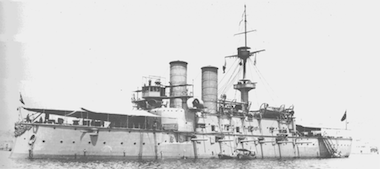
As part of Sultan Abdülaziz's policy to modernize the Ottoman navy, Mesudiye (meaning “Happiness” in Ottoman Turkish) was commissioned to the British Thames Iron Work Company in 1872. Construction began in 1873, and the ship was launched in 1875 upon its completion. Due to delays in fulfilling the financial obligations arising from the contract, as well as logistical drawbacks, the Ottoman Empire only managed to dispatch Mesudiye from London to Istanbul on November of the same year, joining the navy in early 1876.
Mesudiye quickly became a prominent fixture in the Ottoman fleet, participating in various naval operations and exercises. During the Turco-Russian War of 1877-1878, she played a significant role in defending Ottoman interests in the Black Sea. In 1891, Mesudiye underwent a series of maintenance and upgrade works in Istanbul, aimed at enhancing her firepower and defensive capabilities.
During the Turco-Greek War of 1897, a tragic incident occurred when three of Mesudiye's boilers exploded while departing from Istanbul on 19 March 1897. This unforeseen event significantly hampered the ship’s ability to operate effectively at sea, prompting the Ottoman authorities to reconsider her future role and undertake a comprehensive modernization effort.
The modernization plan for Mesudiye initially envisioned refurbishment works at the Imperial Arsenal (Tersane-i Amire) in Istanbul. However, due to technical constraints, Mesudiye was eventually sent to Genoa, Italy, along with another vessel, Asar-ı Tevfik, in January 1899 for extensive modernization works. The modernization process faced several challenges, including financial difficulties and labor disputes, which led to delays in completing the renovation works. It was not until early 1904 that Mesudiye emerged from the shipyard in Genoa, thoroughly modernized and equipped with state-of-the-art weaponry and propulsion systems.
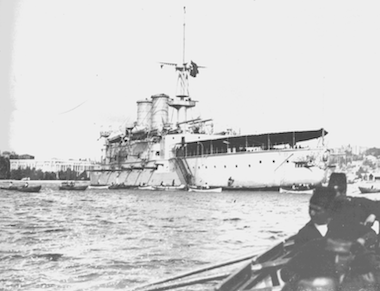
Following her modernization, Mesudiye participated in various naval exercises and operations, including the Ottoman Navy's first fleet maneuver in twenty years, held in 1909. This marked a significant milestone in the empire's naval reforms, spearheaded by a British advisory mission. Mesudiye's active involvement continued into July 1911, when she joined forces with pre-dreadnoughts Barbaros Hayreddin and Turgut Reis, along with other vessels, for training exercises and a routine cruise to Beirut. However, the voyage back to Istanbul was abruptly interrupted by the outbreak of the Turco-Italian War in September 1911. Mesudiye and the fleet sought refuge at Nagara Point near the Dardanelles before returning to Istanbul, where Mesudiye was subsequently assigned to the Reserve Division. Despite the conflict, Mesudiye remained docked, as the Ottoman authorities kept the fleet in port due to escalating tensions in the Balkans, anticipating the impending Balkan Wars.During the Balkan Wars, Mesudiye actively took part in the bombardment against Bulgarian forces attacking the Çatalca Line in November 1912. Following the slight damage incurred during the Battle of Elli between the Greek and Ottoman navies on 16 December 1912, she lost three of its cannons in the Battle of Lemnos on 18 January 1913. Despite not suffering severe damage, Mesudiye withdrew from the battle due to boiler issues. She also took part in the operation against Bulgarian forces controlling Şarköy on 5 February 1913, bombarding their positions. Following this, the ship, along with the rest of the Ottoman fleet, remained in port until the armistice brought an end to hostilities in April, marking the conclusion of Mesudiye's wartime activities.
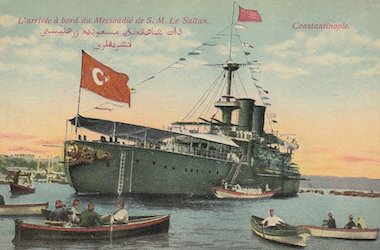
With the outbreak of the First World War and the Ottoman Empire's declaration of mobilization on 3 August 1914, Mesudiye began preparations for its final official duty. At the beginning of the war, Mesudiye together with three torpedo destroyers and four torpedo boats was conducting exercises off the coast of Erdek. However, on 30 August 1914, Enver Pasha ordered Mesudiye to join the fleet in Çanakkale.
Upon reaching Çanakkale in September 1914, there were various plans for Mesudiye's anchoring position, including coordinating fire with batteries and relocating to different positions. After Yavuz and Midilli joined the Ottoman fleet, Admiral Souchon decided that due to her lack of essential guns and advanced evacuation equipment, Mesudiye should anchor defensively at the Dardanelles' entrance with its land-facing cannons removed. She did so in Sarısığlar Cove on 17 September 1914.
Following the French and British naval bombardment of Seddülbahir on 3 November, there was a surge in allied naval activities at the strait's entrance. To prepare for an operation, the allies utilized submarines, then a cutting-edge technology, to clear the mine lines. By late November 1914, the French submarine Faraday was spotted at the strait's entrance but withdrew unharmed after being fired upon. Moreover, on 5 December, the British submarine B-11 successfully trailed Turkish ships from a distance of two miles within the Dardanelles. Despite her role in safeguarding the mine lines and strait entrance at Sarısığlar Cove, Mesudiye became a target for the allied navy during these submarine operations. The submarines' limited battery life was preventing any attack on Mesudiye, but following maintenance to protect her helm, rudder, and periscope, B-11 was authorized to engage the Turkish warship.
On the fateful morning of 13 December 1914, the British submarine B11, led by Lieutenant Norman Holbrook, infiltrated the Dardanelles. Encountering Mesudiye, at around 11:30 am, she launched two torpedoes at a range of 800 meters, striking its stern and causing severe damage. Despite Mesudiye's attempt to retaliate, and supporting fire from Turkish coastal batteries, the warship succumbed to the onslaught and capsized, claiming the lives of 10 officers and 24 enlisted men. Salvaging operations recovered Mesudiye's guns, to be used for reinforcing Dardanelles' defenses. These guns were later incorporated into "Battery Mesudiye" in the Dardanelles, and proved instrumental in the sinking of the French battleship Bouvet on 18 March 1915.
On 18 June 2004, a team of Turkish navy divers coordinated by Admiral Metin Ataç dove to the wreck of Mesudiye, reaching the ship for the first time 90 years after it was sunk.
![]()
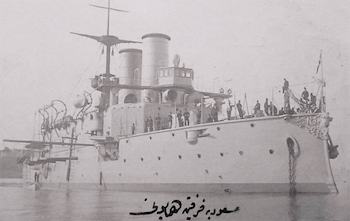
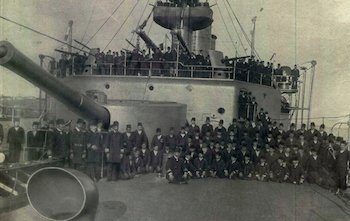
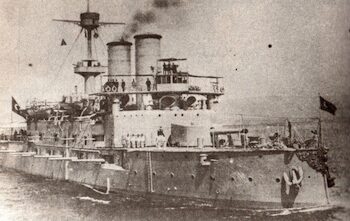
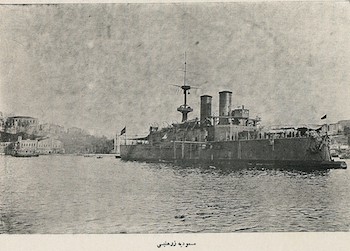
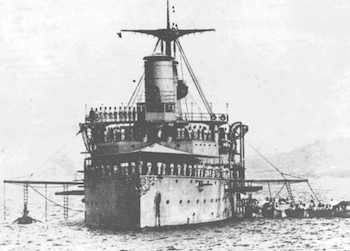
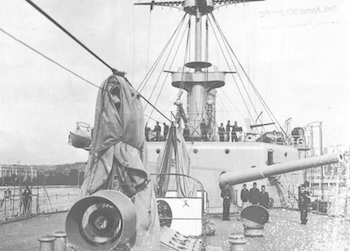
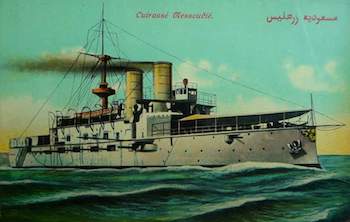
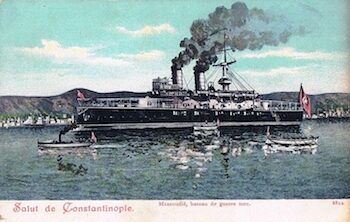
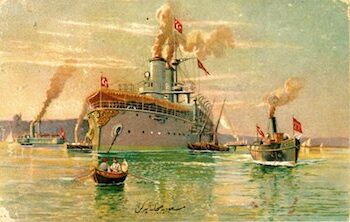
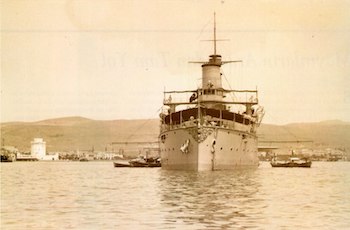
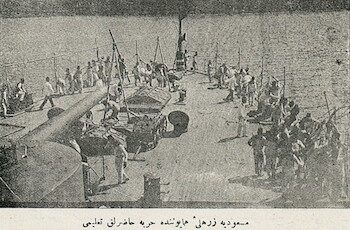
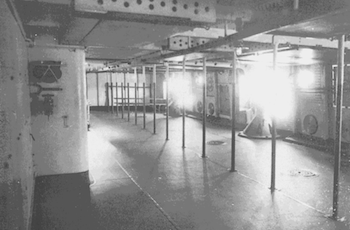
Location of the wreck of Mesudiye
PAGE LAST UPDATED ON 1 APRIL 2024